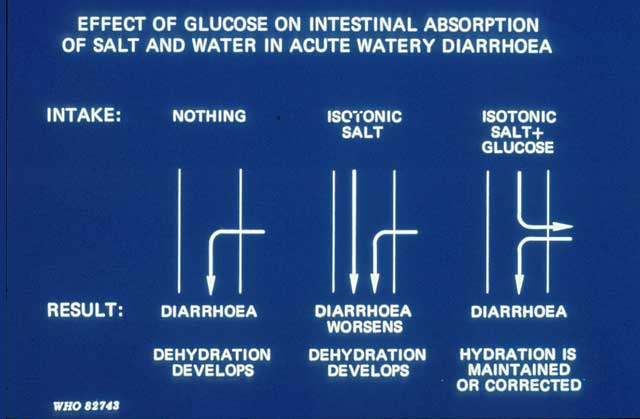
|
Acute Diarrhoeal Diseases - Clinical Features and Management |
8 of 36 Print | Close

 |

The importance of the glucose in the solution is shown here. It enhances the
absorption of sodium and water in the intestine so that, even though the ingestion, of isotonic saline alone can worsen diarrhoea, when glucose is
present electrolytes and water are absorbed and dehydration is corrected.
TABLE 1. ASSESSMENT OF DEHYDRATION AND FLUID DEFICIT*
| Signs and symptoms |
Mild dehydration |
Moderate dehydration |
Severe dehydration |
General appearance and condition
- infants and young children |
Thirsty; alert; restless |
Thirsty; restless, or lethargic but irritable when touched |
Drowsy; limp, cold, sweaty, cyanotic extremities; may be comatose |
| - older children and adults |
Thirsty; alert; restless |
Thirsty; alert; giddiness with postural changes |
Usually conscious; apprehensive; cold, sweaty cyanotic extremities; wrinkled skin of fingers and toes; muscle cramps |
| Radial pulse |
Normal rate and volume |
Rapid and weak |
Rapid, feeble, sometimes impalpable |
| Respiration |
Normal |
Deep, may be rapid |
Deep and rapid |
| Anterior fontanelle |
Normal |
Sunken |
Very sunken |
| Systolic blood pressure |
Normal |
Normal - low |
Less than 10,7 kPa (80mmHg); may be
unrecordable |
| Skin elasticity |
Pinch retracts immediately |
Pinch retracts slowly |
Pinch retracts very slowly (>2 seconds) |
| Eyes |
Normal |
Sunken |
Deeply sunken |
| Tears |
Present |
Absent |
Absent |
| Mucous membranes |
Moist |
Dry |
Very dry |
| Urine flow |
Normal |
Reduced amount and dark |
None passed for several hours; empty bladder |
| % body weight loss |
4-5% |
6-9% |
10%, or more |
*Source: A Manual for the Treatment of Acute Diarrhoea, unpublished document WHO/CDD/SER/80.2(1980)
|
|